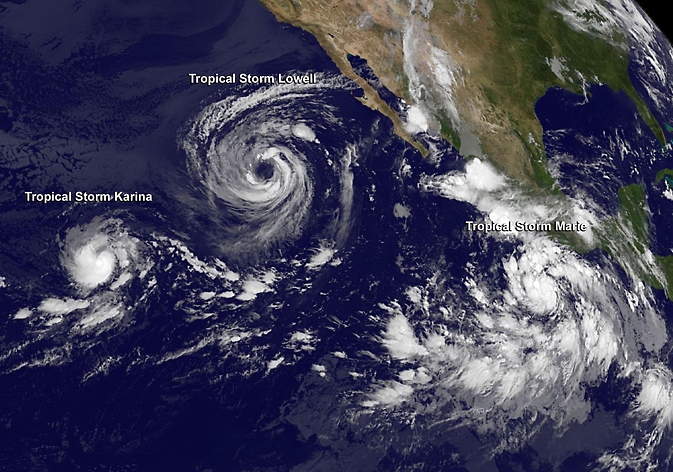NASA Sees Tropical Storm Karina Get a Boost

NOAA's GOES-West satellite captured Tropical Storm Karina (left), Tropical Storm Lowell (center) and Tropical Storm Marie (right) in an infrared image on Aug. 22 at 5 a.m. EDT as they moved through the Eastern Pacific Ocean. Image Credit: NASA/NOAA's GOES Project
The Tropical Rainfall Measuring Mission or TRMM satellite passed directly above the center of Tropical Storm Karina on August 22, 2014 at 0151 UTC (Aug. 21 at 9:51 p.m. EDT).
A rainfall analysis that used data from TRMM's Microwave Imager (TMI) showed that storms near Karina's center were dropping rain at a rate near 25 mm/1 inch per hour.
Where the heaviest rainfall was occurring, TRMM spotted a couple of towering thunderstorms as high as 15 km (~9 miles).
NOAA's GOES-West satellite captured Tropical Storm Karina, Tropical Storm Lowell and Tropical Storm Marie in an infrared image on Aug. 22 at 5 a.m. EDT.
Karina appeared to be in the lead of the triple tropical train of storms moving through the Eastern Pacific Ocean. The image showed how much smaller and compact Karina is in comparison to Tropical Storm Lowell.
At 11 a.m. EDT, Tropical Storm Karina's maximum sustained winds had increased to near 70 mph (110 kph), and the National Hurricane Center (NHC) noted that some fluctuations in intensity are possible before Karina begins to weaken on August 23.
The center of Tropical Storm Karina was located near latitude 15.0 north and longitude 135.6 west, about 1,325 miles (2,130 km) east of Hilo, Hawaii. Karina is moving to the northeast near 3 mph (6 kph) and is expected to turn to the east-northeast as it continues being affected by nearby Tropical Storm Lowell.
Forecaster Roberts at NHC noted that in two days Karina should be on a weakening trend because the storm will be moving into cooler waters and it will run into stable, dry air.
Text credit: Rob Gutro
NASA's Goddard Space Flight Center
Media Contact
More Information:
http://www.nasa.gov/content/goddard/karina-eastern-pacific/All latest news from the category: Earth Sciences
Earth Sciences (also referred to as Geosciences), which deals with basic issues surrounding our planet, plays a vital role in the area of energy and raw materials supply.
Earth Sciences comprises subjects such as geology, geography, geological informatics, paleontology, mineralogy, petrography, crystallography, geophysics, geodesy, glaciology, cartography, photogrammetry, meteorology and seismology, early-warning systems, earthquake research and polar research.
Newest articles

Sea slugs inspire highly stretchable biomedical sensor
USC Viterbi School of Engineering researcher Hangbo Zhao presents findings on highly stretchable and customizable microneedles for application in fields including neuroscience, tissue engineering, and wearable bioelectronics. The revolution in…

Twisting and binding matter waves with photons in a cavity
Precisely measuring the energy states of individual atoms has been a historical challenge for physicists due to atomic recoil. When an atom interacts with a photon, the atom “recoils” in…

Nanotubes, nanoparticles, and antibodies detect tiny amounts of fentanyl
New sensor is six orders of magnitude more sensitive than the next best thing. A research team at Pitt led by Alexander Star, a chemistry professor in the Kenneth P. Dietrich…





















